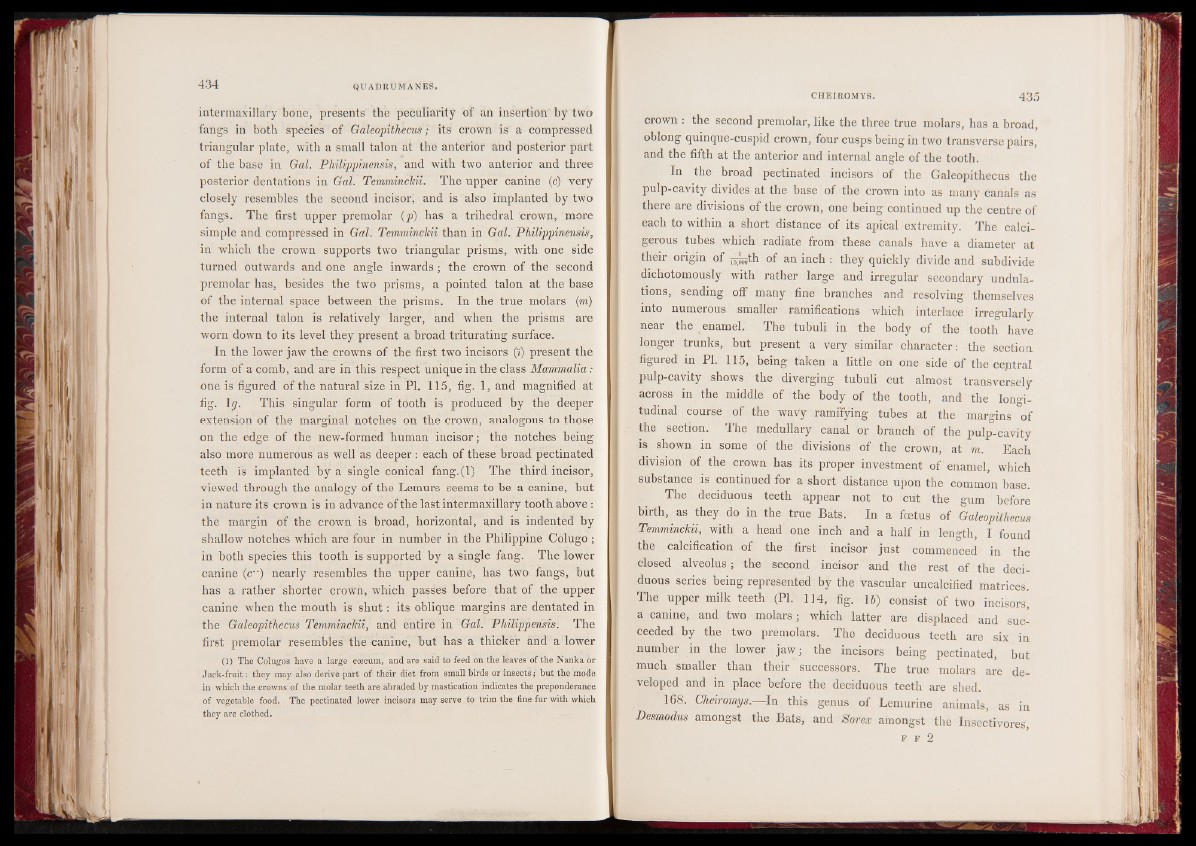
intermaxillary bone, presents the peculiarity of an insertion by two
fangs in both species of Galeopithecus;its crown is" a compressed
triangular plate, with a small talon at the anterior and posterior part
of the base in Gal. Philippinensis, and with two anterior and three
posterior dentations in Gal. Temminckii. The upper canine (c) very
closely resembles the second incisor, and is also implanted by two
fangs. The first upper premolar (p) has a trihedral crown, more
simple and compressed in Gal. Temminckii than in Gal. Philippinensis,
in which the crown supports two triangular prisms, with one side
turned outwards and one angle inwards; the crown of the second
premolar has, besides the two prisms, a pointed talon at the base
of the internal space between the prisms. In the true molars (m)
the internal talon is relatively larger, and wrhen the prisms are
worn down to its level they present a broad triturating surface.
In the lower jaw the crowms of the first two incisors (i) present the
form of a comb, and are in this respect unique in the class Mammalia .-
one is figured of the natural size in PI. 115, fig. 1, and magnified at
fig. 1 g. This singular form of tooth is produced by the deeper
extension of the marginal notches on the crown, analogous to those
on the edge of the new-formed human incisor ; the notches being
also more numerous as well as deeper : each of these broad pectinated
teeth is implanted by a single conical fang.(l) The third incisor,
viewed through the analogy of the Lemurs seems to be a canine, but
in nature its crown is in advance of the last intermaxillary tooth above :
the margin of the crown is broad, horizontal, and is indented by
shallow notches which are four in number in the Philippine Colugo ;
in both species this tooth is supported by a single fang. The lower
canine (c”) nearly resembles the upper canine, has two fangs, but
has a rather shorter crown, which passes before that of the upper
canine when the mouth is shut: its oblique margins are dentated in
the Galeopithecus Temminckii, and entire in Gal. Philippensis. The
first premolar resembles the canine, but has a thicker and a lower
(1) The Colugos have a large coecum, and are said to feed on the leaves of the Nanka Or
Jack-fruit: they may also derive part of their diet from small birds or insectsbut the mode
in which the crowns of the molar teeth are abraded by mastication indicates the preponderance
of vegetable food. The pectinated lower incisors may serve to trim the fine fur with which
they are clothed.
crown : the second premolar, like the three true molars, has a broad,
oblong quinque-cuspid crown, four cusps being in two transverse pairs,
and the fifth at the anterior and internal angle of the tooth.
In the broad pectinated incisors of the Galeopithecus the
pulp-cavity divides at the base of the crown into as many canals as
there are divisions of the crown, one being continued up the centre of
each to within a short distance of its apical extremity. The calci-
gerous tubes which radiate from these canals have a diameter at
their origin of j^ th of an inch : they quickly divide and subdivide
dichotomously with rather large and irregular secondary undulations,
sending off many fine branches and resolving themselves
into numerous smaller ramifications which interlace irregularly
near the enamel. The tubuli in the body of the tooth have
longer trunks, but present a very similar character: the section
figured in PI. 115, being taken a little on one side of the central
pulp-cavity shows the diverging tubuli cut almost transversely
across in the middle of the body of the tooth, and the longitudinal
course of the wavy ramifying tubes at the margins of
the section. The medullary canal or branch of the pulp-cavity
is shown in some of the divisions of the crown, at m. Each
division of the crown has its proper investment of enamel, which
substance is continued for a short distance upon the common base.
The deciduous teeth appear not to cut the gum before
birth, as they do in the true Bats. In a foetus of Galeopithecus
Temminckii, with a head one inch and a half in length, I found
the calcification of the first incisor just commenced in the
closed alveolus; the second incisor and the rest of the deciduous
series being represented by the vascular uncalcified matrices.
The upper milk teeth (PI. 114, fig. 16) consist of two incisors,
a canine, and two molars; which latter are displaced and succeeded
by the two premolars. The deciduous teeth are six in
number in the lower jaw; the incisors being pectinated, but
much smaller than their successors. The true molars are developed
and in place before the deciduous teeth are shed.
168. Cheiromys. In this genus of Lemurine animals, as in
Desmodus amongst the Bats, and Sorex amongst the Insectivores
f f 2